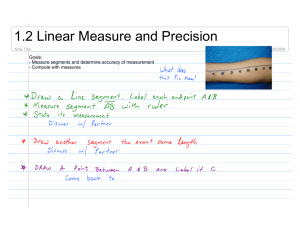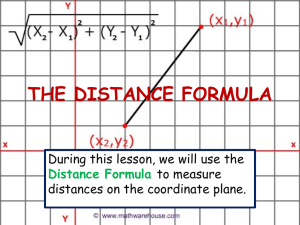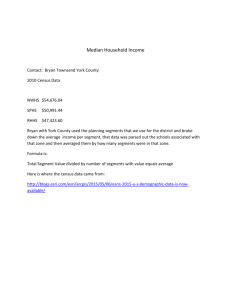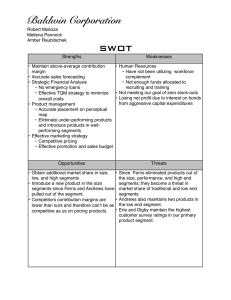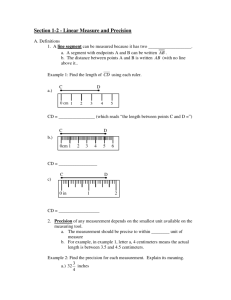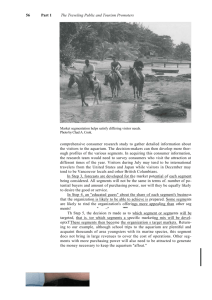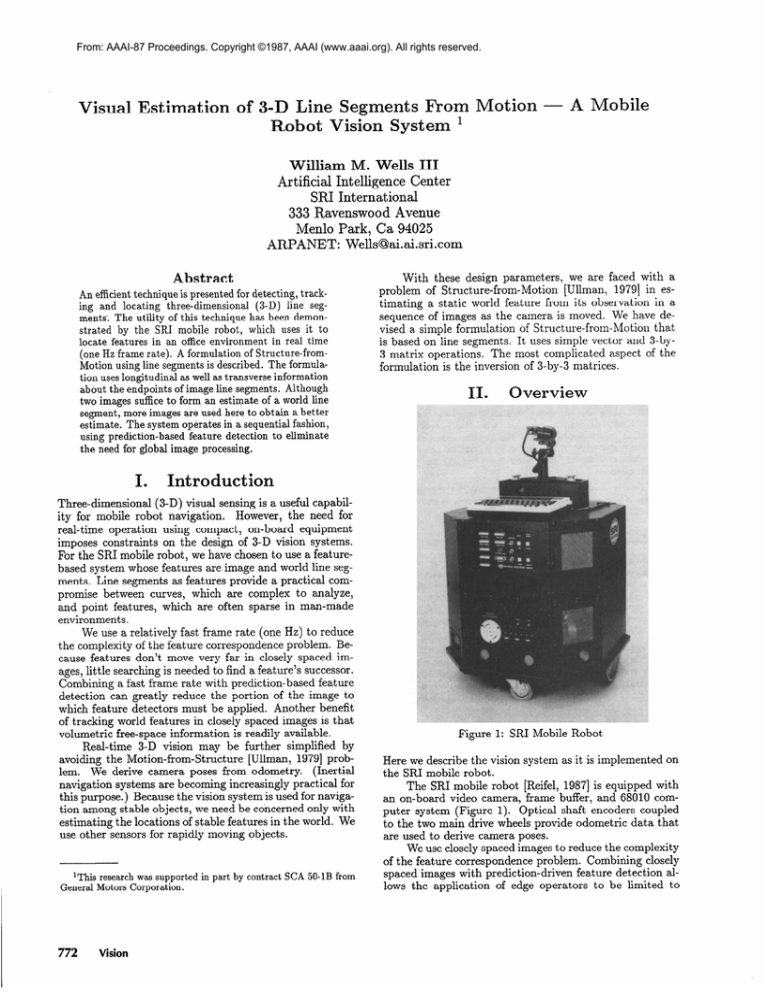
From: AAAI-87 Proceedings. Copyright ©1987, AAAI (www.aaai.org). All rights reserved.
Visual
Estimation
of 3-D Line Segments From Motion
Robot Vision System 1
’
William M. Wells III
Abstract
lThis research was supported in part by contract
General Motors Corporation.
Vision
With these design parameters,
we are faced with a
problem of Structure-from-Motion
[Ullman,
19791 in estimating
a static world feature from its observation
in a
sequence of images as the camera is moved. We have devised a simple formulation
of Structure-from-Motion
that
It uses simple vector and 3-byis based on line segments.
3 ma.trix operations.
The most complicated
aspect of the
formulation
is the inversion of 3-by-3 matrices.
II.
verview
Introduction
Three-dimensional
(3-D) visual sensing is a useful capability for mobile robot navigation.
However, the need for
real-time
operation
using compact,
on-board
equipment
imposes constraints
on the design of 3-D vision systems.
For the SRI mobile robot, we have chosen to use a featurebased system whose features are image and world line segments. Line segments as features provide a practical
compromise between
curves, which are complex
to analyze,
and point features,
which are often sparse in man-made
environments.
We use a relatively fast frame rate (one Hz) to reduce
the complexity
of the feature correspondence
problem.
Bemove very far in closely spaced imcause features
don
successor.
ages, little searching is needed to find a feature
Combining
a fast frame rate with prediction-based
feature
detection
can greatly reduce the portion of the image to
which feature detectors
must be applied.
Another benefit
of tracking world features in closely spaced images is that
volumetric
free-space
information
is readily available.
Real-time
3-D vision may be further
simplified
by
avoiding the Motion-from-Structure
[Ullman, 19791 problem.
We derive camera poses from odometry.
(Inertial
navigation
systems are becoming increasingly
practical
for
this purpose.)
Because the vision system is used for navigation among stable objects,
we need be concerned only with
estimating
the locations of stable features in the world. We
use other sensors for rapidly moving objects.
772
A Mobile
Artificial Intelligence
Center
’
SRI International
333 Ravenswood Avenue
Menlo Park, Ca 94025
ARPANET:
WellsQai.ai.sri.com
An efficient technique is presented for detecting, tracking and locating three-dimensional
(3-D) line segments; The utility of this technique has been demonstrated by the SRI mobile robot, which uses it to
locate features in an office environment in real time
(one Hz frame rate). A formulation of Structure-fromMotion using line segments is described. The formulation uses longitudinal as well as transverse information
about the endpoints of image line segments. Although
two images suffice to form an estimate of a world line
segment, more images are used here to obtain a better
estimate. The system operates in a sequential fashion,
using prediction-based
feature detection to eliminate
the need for global image processing.
I.
-
SCA 50-1B from
Figure
1: SRI
Mobile
Robot
Here we describe the vision system as it is implemented
on
the SRI mobile robot.
The SRI mobile robot [Reifel, 19871 is equipped with
an on-board video camera, frame buffer, and 68010 computer system (Figure
1). Optical shaft encoders coupled
to the two main drive wheels provide odometric
data that
are used to derive camera poses.
We use closely spaced images to reduce the complexity
of the feature correspondence
problem.
Combining
closely
spaced images with prediction-driven
feature detection
alto
lows the application
of edge operators
to be limited
small areas of the image that are near predictions,
thus
eliminating
the need for global image processing.
(Prediction based feature detection
was used to advantage
in
Goad
model based vision system [Goad, 19861.) Image
line segments are detected by a software edge tracker that
provides least-squares
fits of line segments
to linear image edge features.
The edge tracker is directed
by prototype image segments whose origin will be described below. The tracker finds sets of candidate
segments that are
close to each prototype.
(The measure of such closeness
is discussed in section III.B..)
We require candidate
edge
segments to have the same gradient sense or “contrast polarity” as their predecessors.
Our system uses a sequential
3-D line segment estimator to infer world line segments from sequences
of corresponding
image line segments.
The system operates
in
three phases:
“prospecting,”
“bootstrapping,”
and “sequential updating. ” “Prospecting”
segments, the first prototype segments
the system uses, are generated
so that
the feature detection
component
will find new image fea,tures. The “bootstrapping”
phase is then used as a prelude
to the. “sequential
updating
phase.”
All prototypes
generated during bootstrapping
are segments
that were detected in the preceding
image.
While bootstrapping,
we
entertain
alternative
hypotheses
about a feature
successors in a small tree of possible correspondence
sequences.
When the tree achieves a minimum depth, we use a nonsequential form of the 3-D segment estimator
(described
in
section 1II.D.) to generate a world feature estimate
as well
as a consistency
measure for each sequence in the tree. If
the most consistent
sequence meets a minimum consistency
threshold, it is promoted to sequential updating;
otherwise,
it is discarded.
During
the “sequential
updating”
phase,
we use
the sequential
form of the 3-D segment
estimator
(section II1.D.).
Newly detected image features are folded into
world feature estimates
as each new picture arrives. Previous 3-D estimates
are used to generate prototype
segments
to direct the feature detector.
The prototype
segments are
generated by taking the central projections
of the previous
3-D segment estimates
into the image plane using the new
camera pose. The detected image feature that is closest to
the prototype
is, if close enough, used as the successor.
The
system
tracks
a set of environment
al features
bv
The robot finds walls by fitting planes to sets of perceived 3-D segments.
These segments are grouped using
a co-planarity
measure.
Once the walls have been located
the robot servos to a path which is centered between the
walls.
Figure 2 shows an intensity
image the robot saw in
a hallway. Figure 3 displays a stereo view of an unedited
collection of line segments that were estimated
by the robot
a.nd used to guide its path down the hallway.
The frame
--~
Figure
2: Hallway
rate was one Hz, while the robot moved at 30 mm/s. Most
of the segments that the robot gathered were vertical.
This
is a consequence
of the way the “prospecting”
segments are
arranged,
the motion of the robot, and the characteristics
of the hallway.
Occasionally
the system will encounter
a seemingly
consistent
set of miscorrespondences,
which will lead to an
incorrect
hypothesis
surviving
to the sequential
updating
phase. Such hypotheses
fail quickly when subjected
to the
long-term
consistency
requirement.
In the future,
we plan to investigate
the use of acquired models within this framework.
Such models may
provide a means to measure the motion of the robot using
Motion-from-Structure.
Models may also make it possible
to track moving objects.
We plan to increase the frame
rate of the vision system by installing a 68020 computer in
the robot, perhaps using several CPU boards.
I.
Estimation
of 3Segments
In this section,
we present
a simple
formulation
of
Structure-from-Motion
that is based on line segments.
It
uses longitudinal
as well as transverse
information
about
segment endpoints.
Given a sequence of images with corresponding
line segment features,
we estimate
a 3-D line
segment that minimizes
an image error measure summed
over the sequence of images.
Camera poses are assumed
to be known.
In section 1II.A.) we discuss the choice of line segments
as features to be used within the paradigm
of Structurefrom-Motion.
We then define an image-based
measure of
the discrepancy
between two line segments.{section
IILB.).
In section III.C., we express the error measure in terms of
a world line segment a.nd its projection
as detected in the
a 3-D segment which best fits a
image. We then estimate
sequence of observations
by varying the segment to minimize the error measure summed over a sequence
of images. This yields a problem of nonlinear
minimization.
In
section IILD., we describe a sequential
estimator
that linearizes the problem.
The robot uses an implementation
of
this linearized sequential
estimator
to estimate
3-D world
line segments .
Wells
773
Figure
A.
3: Estimated
Simple Structure-from-Motion
Line Segments
Using-
Structure-from-Motion
is a useful and popular paradigm
for robotic
visual perception
[Aggarwal,
19861.
Early
work in feature-based
motion analysis was based on world
and image points [Roach and Aggarwal,
19791 [LonguetHiggens, 19811 [H annah, 19801 [Gennery, 19821, while later
research focused on straight
lines [Yen and Huang, 19831.
Points and lines also have been used widely in robotic vision [Goad, 1986] [Lowe, 19851.
Straight
line segments are useful features for motion
analysis and robotic
vision applications
[Ulhnan,
19791 .
Point features are as simple to analyze, but unfortunately,
prominent
point features
can be scarce,
particularly
in
man-made
environments.
Cultural
and industrial
scenes
usually contain prominent
linear features that can be reliably detected by edge finders.
Although
cultural
and industrial scenes often also have significant
curved features,
such features are more difficult to analyze than points or
lines.
Edge finders are very good at determining
the transverse position
of a linear feature in an image.
They are
less accurate
at finding the longitudinal
(along the edge)
position of the ends of a linear feature, as they usually use
thresholds
to locate feature terminations.
Although
the
longitudinal
information
is less reliable than the transverse
information,
we believe that it is still useful information,
which would be lost if linear features were abstracted
into
straight
lines rather than line segments.
Line segments
carrying endpoint information
present a balance between
analytical
simplicity
and practicality
as image features.
B.
Image Error Measure
We propose the following as a component
of the measure
of the discrepancy
between a pair of image line segments
(Figure 4):
E = [o!(P - S) . LIZ + [P(P - S) * Q2
774
Vision
Line Segments
.
(1)
Figure
4: Image
Error
Measure
Here c represents
the squared error due to one pair
of corresponding
endpoints.
The total error for the corresponding segments is the sum of the errors for both corresponding endpoint pairs. P and S are two-vectors
describing the image locations of endpoints of line segments IS and
r respectively.
a unit vector
f, is a unit vector parallel
perpendicular
to u.
to c, while
C is
The longitudinal
and perpendicular
components
are
weighted by a and /?. We have settled on /3/o = 16 empirically,
giving perpendicular
errors 16 times the weight
of longitudinal
errors. This was deemed to be the smallest
weighting
of longitudinal
errors that provided estimates
that were “reasonably”
accurate
longitudinally,
while not
overly disturbing
the transverse
components
of the estimates with less reliable longitudinal
information.
If an image line segment is clipped by the boundaries
of an image, that endpoint
has little meaningful
longitudinal informat ion.
One strategy
for this case sets (Y to
zero, ignoring
ular image.
c.
3-
the longitudinal
information
in that
partic-
Noting
that
l^i.
(p - s) = 0, we may rewrite
Eq. (2) as
e = ~2[~(p-s).(Xli+X,h)12+~2~~(p-s).(wo~+w~~)]2
a2[$p-s).(Xli+X,h)12+~2[J-(p-s).(woc3+wni%)]2
Error Measure
,
or
e=~[(p-s).il’+$[(p-s).o]2
.
1
Since s = C + 6s^ for some 6, 4.0
may write
. E = $[(p
1
- C) - 21” + $[(p
= 0, and s^. J? = 0, we
- C) * a2
*
(3)
Now we will use a relation
of central projection
to
get the error in terms of P rather than p. The standard
“z-division”
form of central projection
may be written as
follows (Figure 5):
(P-C)=
f(P-C)
z
where
z = (P-C).fi
.
Letting
Figure
5: Imaging
a
Geometry
We may recast Eq.(l)
in terms of world S-vectors
(Figure 5). An endpoint of 3-D segment T is P, their central
projections
into the image plane are r and p respectively.
The endpoint of Q that corresponds
top is s. Here, p and s
are 3-vectors that refer to locations
of-image points in the
3-space in which the image plane is embedded.
C is the
projection
center of the camera, and f is the focal length
of the camera. The image plane and Q define an orthonorma1 basis composed of i, which is a 3-D unit vector parallel
to a; 6, which is a 3-D unit vector normal ,to the image
plane; and 6, which is perpendicular
to both E and fi. Two
additional
unit vectors are defined by r”, which is the normalization
of (P - C), and s^, which is the normalization
of (s - C).
The image error measure may rewritten
as:
~=012[(p-s).i]2+p2[(p-s).~]2
Next,
convenient
we express the error
unit vectors.
Let
.
measure
in terms
6
=
normalize(i
X i)
,
i
=
normalize(s^
X 6)
,
(2)
of more
and
Then
we can express
8
2
8 and i
in terms
= w,6+w,ii
= xli+A,ii
of i, 6, and hi:
.
=- 4
Xl
Xl
=Pf
=Pf
b
b
,,
wo
wo
Eq. (3) may be written
E = -${a’[(P
as
- C) . iI2 + b2[(P - C) .6]“}
*
(4)
If we consider e to be the squared error for a given endpoint
due to detection in the ith member of a set of images, then
the total error for a given endpoint would be given by
E
E = 7
J${ai[(P
${Ui[(P
t
- Ci)
Cj) *
’Zi]’
Zj]’ + bf[(P
b,2[(P - Ci)
Ci) *
’6ij”)
6ij”)
e.
Varying P to minimize E
E will yield an estimate for the 3-D
segment endpoint.
This is a nonlinear estimation
problem
by virtue of the factor of l/z: .
D.
Approximation
and Minimization
There are many ways to minimize E. We will discuss a
sequential
method that works well in practice,
which is
designed for an application
where a set of images arrives
sequentially
and where an estimate
of the 3-D feature is
desired after each image. This is often the case in robotic
guidance.
The technique
involves approximating
z; = z(P) by
z- = z(P-),
where P- is the previous estimate
of P. The
process may be bootstrapped
by using a nominal starting value for Zi. This method
essentially
substitutes
a
“pseudo-art hographic”
approximation
(a different approximation for each image) for perspective
projection.
The error terms ei become invariant to translations
of P along &.
The approximation
is exact for points on one plane in the
world, namely the plane containing
P, that is parallel to
the image plane. Within the framework of the I;linimization, this is also equivalent
to replacing
the (unsquared)
error functions
of P by second-order
Taylor expansions.
Wells
775
The expansions
are about the point where the ray emanating from Ci along sl; pierces the previously
mentioned
plane.
The approximated
squared error measure is also
easy to visualize,
as it is the weighted sum of the squared
perpendicular
distances
of P from a pair of planes.
The
two planes both contain the camera center and the endpoint s of g. One contains the segment c’, while the unit
vector 6 lies in the other.
After this$approximation,>he
ith error (Eq. (4)) may
be written as
This is quadratic
matrix notation,
in P and its sum is easy to minimize.
Ei = $(P g
F(P
*-
C;)Tti;2T(P
In
- Ci) +
- Ci)T6i6T(P
@OllCllX3iO~
We have described
an efficient
technique
for detecting,
tracking,
and locating
three-dimensional
line segments as
As the robot
demonstrated
on the SRI mobile robot.
moves about, it makes good estimates
of environmental
3-D line segments using Structure-from-Motion.
In the future, we plan to investigate
whether the statistical
characteristics
of the image line segment detector
can provide a maximum-likelihood
basis for the estimator.
This would also yield values for for the weights cy and @
which appear above.
Acknowledgments
I thank David Marimont for our many conversations
about
robotic vision, including some on the general topic of the
longitudinal
information
of endpoints
of line segments.
Marimont’s
thesis [Marimont,
19861 provides a good discussion of feature estimation
for robotics.
- C;)
efesences
[Aggarwal, 19861 J. K. Aggarwal.
Motion
and timevarying imagery - an overview.
In Workshop on Motion: Representation
and Analysis, pages l-6, IEEE,
Charleston,
South Carolina,
May 1986.
then
ei = (P - C;)TM;(P
7
- Ci)
or
ci = PTMiP
- 2PTMiCi
.
+ CTM;Ci
M
=
v=
xMi
[Hannah, 19801 Marsha Jo Hannah.
Bootstrap
stereo.
In
Proceedings of the First Annual National Conference
on Artificial Intelligence,
pages 38-40, American
Association for Artificial
Intelligence,
1980.
c Mici
i
k
allows us to write
=
CCTMiC;
i
the total
squared
error
the gradient
[Longuet-Higgens,
19811 H. C. Longuet-Higgens.
A computer algorithm
for reconstructing
a scene from two
projections.
Nature, 293:133-135,
10 September
1981.
as
E=PTMP-2PTV+k
Setting
.
of E with respect
to P to zero,
O=vpE=2MP-2V
,
or
P=M-‘V
,
provides an easily computed estimate of a 3-D line segment
endpoint viewed in a sequence of images.
Two images are sufficient for computing
an estimate
of a line segment.
If the camera motion is slight, making the effective baseline short, then the estimate
may be
somewhat
inaccurate
in depth.
If more images are used
and the camera moves appreciably
about some feature in
the world, then the estimate
of that feature improves and
the consistency
of the estimate
may be better evaluated.
There are combinations
of line segment
orientation
and camera motion
which are degenerate
and preclude
depth estimates.
In these situations
M will be singular,
or nearly so in the presence of noise.
Vision
[Gennery, 19821 Donald
B. Gennery.
Tracking
known
three-dimensional
objects.
In Proceedings
of the National Conference
on Artificial Intelligence,
pages 1317, August 18-20 1982.
Fast 3-D Model Based Vision.
[Goad, 19861 Ch ris Goad.
In Alex P. Pentland,
editor, From Pixels to Predicates,
Ablex Publishing
Co., 1986.
Defining
776
V.
[Lowe, 19851 David G. Lowe. Perceptual Organization and
Visual Recognition.
Kluwer
Academic
Publishers,
1985.
Inferring Spa[Marimont,
19861 David Henry Marimont.
tial Structure from Feature Correspondences.
Ph.D.
thesis, Stanford University,
1986.
[Reifel, 19871 Stanley
W. Reifel.
The SRI Mobile Robot
Testbed, A Preliminary
Report. Technical Report 413,
SRI International
Artificial
Intelligence
Center, 1987.
[Roach and Agg arwal, 19791 J. W. Roach and J. K. Aggarwal. Computer
tracking
of objects
moving in space.
IEEE Transactions PAMI, PAMI-1(2):127-135,
April
1979.
[Ullman, 19791 Shimon
sual Motion. MIT
Ullman.
The Interpretation
Press, 1979.
of Vi-
[Yen and Huang, 19831 B. L. Yen and T. S. Huang.
Determining
3-D motion and structure
of a rigid body
using straight
line correspondences.
In Proceedings
of the International
Joint Conference
on Acoustics,
Speech and Signal Processing, March 1983.

